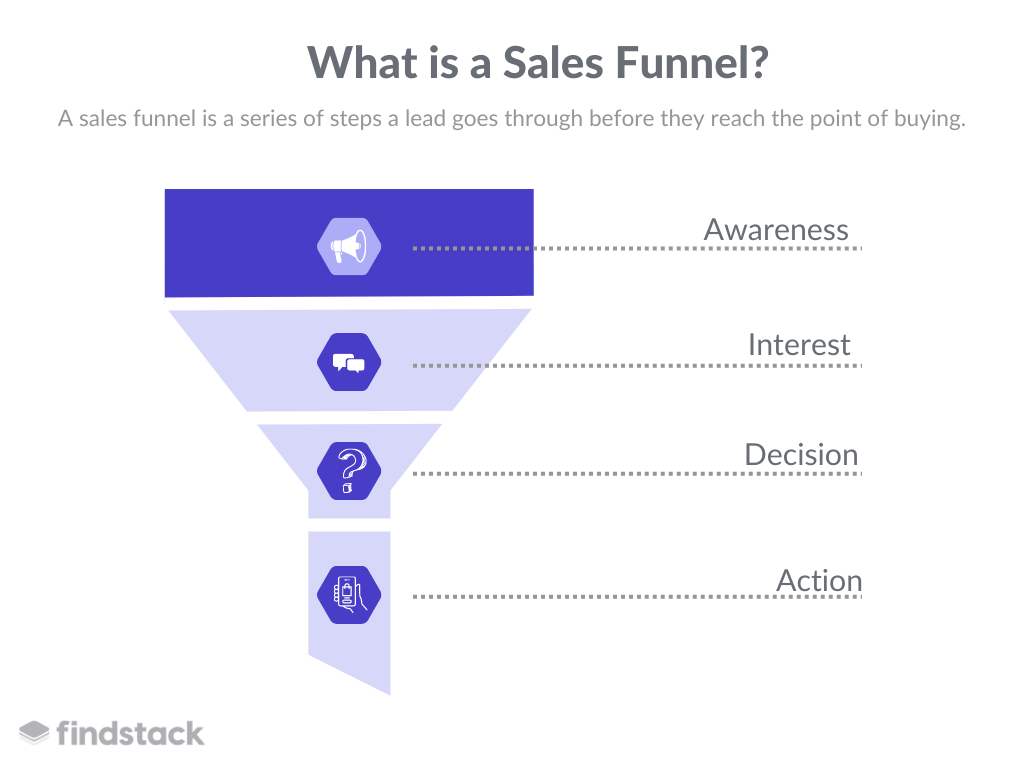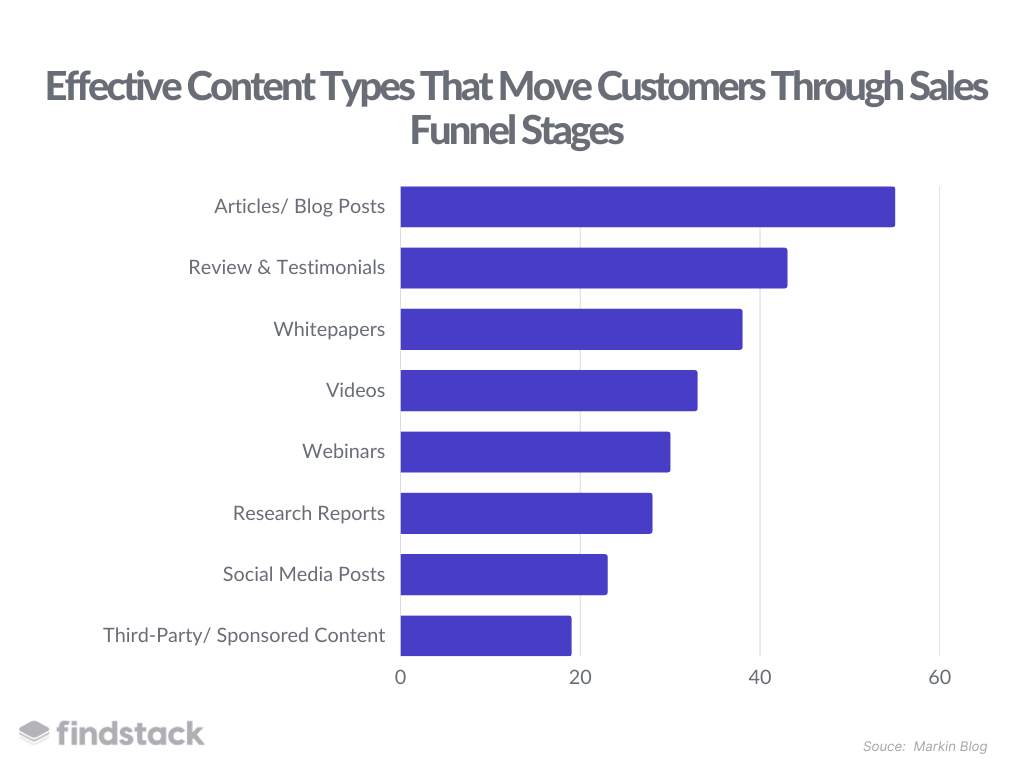Sales Funnel
The phrase sales funnel has long been a buzzword across different industries. But do you actually know what it means? And what it's for?
While most already know that sales funnels are crucial for any business looking to convert leads into customers, understanding the concept, its purpose, key components, and the mechanism behind it is a big part of making sure it actually works for you.
Let's get into it.
What is A Sales Funnel?
A sales funnel is a visual representation of the buyer's journey , from the initial stage of awareness to the final stage of conversion.
Sales funnels help businesses understand and optimize their sales process by breaking it down into specific stages. The funnel shape signifies the reduction in the number of prospects as they move closer to becoming customers. Each stage of the funnel represents a step in the customer's decision-making process, and businesses use various marketing and sales tactics to guide prospects through these stages.
Imagine a software company that wants to sell its project management tool. The company's sales funnel might start with a broad audience of potential customers who have never heard of the brand or product. Through targeted advertising, content marketing, and social media campaigns, the company generates awareness to attract visitors to its website. As these prospects interact with the brand, they move down the funnel toward the interest stage , where they review the product and learn more about it. Based on the information they gather, they make a decision about your product or service. Eventually, they move further down the funnel to the action stage , where they make a purchase or sign up for a service.

By providing a framework for understanding and optimizing the buyer's journey, sales funnels play a crucial role in helping businesses convert leads into customers and achieve their revenue goals.
Components of a Sales Funnel
A typical sales funnel comprises four main stages:
# Awareness
The awareness stage is when potential customers first encounter your brand or product. This can occur through various channels, such as online advertising, social media, content marketing, or word-of-mouth referrals. At this stage, the goal is to capture their attention and spark curiosity about your offerings.
# Interest
Once prospects are aware of your brand, they enter the interest stage. Here, they begin to research and gather information about your product or service. This is when they may visit your website, read blog posts, sign up for newsletters, or follow your social media accounts. The aim is to nurture their interest and keep them engaged with your brand.
# Decision
In the decision stage, prospects evaluate whether your product or service meets their needs and requirements. They may compare your offerings with competitors, read reviews, or seek advice from friends and family. At this point, offering free trials, demos, or special discounts can help persuade prospects to choose your brand.
# Action
The final stage of the sales funnel is action, where prospects become customers by making a purchase or signing up for a service. After this point, businesses should focus on customer retention, upselling, and encouraging referrals.
Why Sales Funnels Are Important?
Sales funnels play a critical role in the success of a business because of their capability to provide a structured approach to understanding and guiding prospects through the buyer's journey. With sales funnels, a business can–
Gain a Better Understanding of Customer Behavior
Sales funnels enable businesses to analyze their target audience's behavior at each stage of the buying process. By understanding the needs, desires, and pain points of potential customers, businesses can tailor their marketing efforts and offerings to address these aspects. This understanding helps improve the overall customer experience and increases the likelihood of converting prospects into customers.
Ensure Efficient Resource Allocation
With a clear understanding of the sales funnel, businesses can allocate resources more efficiently. They can identify which marketing channels and tactics are most effective at generating leads and driving conversions at each stage of the funnel. By focusing on high-performing strategies, businesses can optimize their marketing budget and achieve a higher return on investment (ROI).
Enhance Lead Nurturing
Sales funnels help businesses nurture leads more effectively by providing a framework for targeted communication. By segmenting leads based on their position within the funnel, businesses can deliver personalized content, promotions, and offers that resonate with prospects. This targeted approach increases engagement and helps move prospects through the funnel more quickly.
Improve Conversion Rates
A well-optimized sales funnel can lead to higher conversion rates. By addressing bottlenecks and fine-tuning marketing strategies at each stage, businesses can minimize drop-offs and maximize the number of prospects who become paying customers. Higher conversion rates translate into increased revenue and business growth.
Improve Retention and Lifetime Value
Sales funnels don't end with the initial purchase. They also play a vital role in retaining customers and maximizing their lifetime value. By understanding post-purchase behaviors and implementing strategies to keep customers engaged and satisfied, businesses can encourage repeat purchases, upsells, and cross-sells. This long-term focus, supported by CRM solutions that make implementing sales funnels easier, helps businesses maximize the value of each customer relationship.
Optimizing Your Sales Funnel
In today's competitive market, optimizing your sales funnel is essential for driving conversions and achieving business growth. Many businesses leverage software tools to enhance their sales funnel performance, enabling them to understand customer behavior better, automate lead nurturing, and measure the effectiveness of their marketing strategies. In this section, we'll discuss key strategies and considerations for optimizing your sales funnel and maximizing its potential.
1. Analyze Data from Each Stage
To optimize your sales funnel, it's crucial to gather and analyze data from each stage of the funnel. This data will help you identify bottlenecks, customer pain points, and areas for improvement. Use analytics tools like Google Analytics or specialized sales funnel software to track user behavior, conversion rates, and drop-off points.
An e-commerce store may find that many prospects abandon their carts before completing a purchase. By analyzing data from the decision and action stages, the store can identify the reasons for cart abandonment (e.g., high shipping costs, complicated checkout process) and implement solutions to address these issues.
2. Test Different Marketing Tactics
Experiment with various marketing tactics and channels to determine what works best for your target audience at each stage of the funnel. Conduct A/B testing to compare the performance of different ad creatives, headlines, landing pages , or email campaigns.
A software company could test two different headlines for a Facebook ad campaign targeting the awareness stage. By comparing the click-through rates and conversions generated by each headline, the company can identify which one resonates better with its audience and optimize its ad strategy accordingly.
3. Personalize Your Messaging
Tailor your messaging and content to appeal to prospects at each stage of the funnel. Personalization can include addressing prospects by name in email campaigns, customizing website content based on user behavior, or retargeting ads that showcase products or services relevant to a user's browsing history.
An online education platform could segment its email list based on users' interests and send targeted newsletters featuring relevant courses, blog posts, or webinars to nurture leads in the interest stage.
4. Improve the User Experience
Optimizing the user experience on your website, landing pages, and marketing materials can significantly impact your sales funnel performance. Focus on mobile-friendly design, fast loading times, easy navigation, and clear calls-to-action to encourage engagement and conversion.
A B2B company might find prospects dropping off at the interest stage due to a slow-loading website. By optimizing the website's performance and improving page load times, the company can increase the likelihood of prospects staying engaged and moving to the decision stage.

Sales Funnels: Summary
By implementing these strategies and continuously monitoring your sales funnel performance, you can make data-driven decisions that improve your conversion rates and drive business growth.
Understanding and optimizing your sales funnel is crucial for business success. By breaking down the buyer's journey into distinct stages, you can better tailor your marketing and sales strategies to meet customer needs and drive conversions. Remember to analyze data, test different tactics, and personalize your messaging to create a more effective and efficient sales funnel.
Now that you have a comprehensive overview of sales funnels, it's time to apply these insights to your own business and watch your conversions soar.



